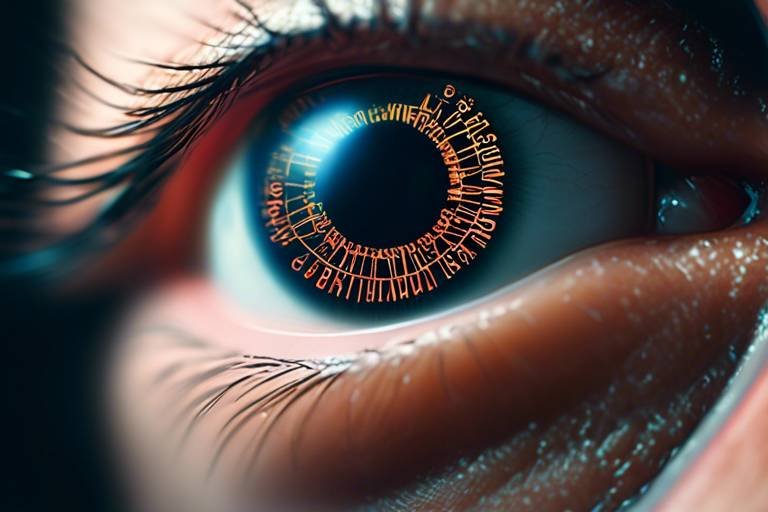AI in Eye Care: A Revolution in Ophthalmology
The integration of artificial intelligence (AI) into ophthalmology is not just a trend; it's a revolution that is reshaping how we approach eye care. Imagine walking into an eye clinic where the diagnostic process is not only faster but also more accurate than ever before. With AI, this is becoming a reality. The technology is enhancing our ability to detect eye diseases early, improving treatment plans, and ultimately leading to better health outcomes for patients. It's like having a supercharged assistant that can analyze vast amounts of data in seconds, pinpointing issues that might take a human eye much longer to detect.
In the realm of eye care, every second counts. Conditions such as glaucoma and diabetic retinopathy can lead to irreversible vision loss if not caught early. AI algorithms are designed to sift through images and patient histories with a level of precision that surpasses traditional methods. This means that patients can receive timely interventions, potentially saving their sight. The excitement surrounding AI in ophthalmology is palpable, as it promises not only to enhance diagnostic accuracy but also to streamline the entire patient experience.
Moreover, the accessibility of eye care is being transformed through innovations like teleophthalmology. Picture a world where patients in remote areas can receive eye examinations from the comfort of their homes, thanks to AI technology. This is not just a dream; it’s happening now. Teleophthalmology leverages AI to analyze data collected during remote exams, ensuring that even those in underserved regions have access to quality eye care. This kind of accessibility is crucial, as it breaks down barriers that have traditionally limited eye health services.
As we delve deeper into the implications of AI in ophthalmology, it becomes clear that this technology is about more than just diagnosis. It is paving the way for personalized treatment plans tailored to individual patients. By analyzing a patient's unique data, AI can help ophthalmologists craft approaches that are specifically designed for conditions like age-related macular degeneration and cataracts. This level of personalization ensures that patients receive the most effective treatments available, enhancing their chances of recovery and improving their quality of life.
Furthermore, AI is not just reactive; it's also proactive. With the power of predictive analytics, healthcare providers can forecast potential eye health issues before they become significant problems. This means that patients can be monitored more effectively, allowing for timely interventions that can dramatically improve long-term outcomes. It's like having a crystal ball for eye health—providing insights that can lead to better preventive care.
In the surgical arena, AI is revolutionizing how procedures are performed. With real-time data and insights at their fingertips, surgeons can enhance their precision during ophthalmic surgeries. This not only increases the safety of the procedures but also improves the overall effectiveness. Imagine a world where complex surgeries are performed with the help of AI guidance, reducing complications and promoting faster recovery times.
Patient engagement is another area where AI shines. With tools that facilitate continuous monitoring of eye health, patients are more involved in their care than ever before. Regular follow-ups and interventions become seamless, ensuring that patients are not just passive recipients of care but active participants in their health journey. This shift in dynamics can lead to improved adherence to treatment plans and better overall outcomes.
As we look to the future, the potential for AI in ophthalmology is boundless. The ongoing research and development in this field are aimed at enhancing every aspect of eye care—from diagnosis to treatment to patient education. However, as we embrace these advancements, it is crucial to address the ethical considerations surrounding AI use. Issues such as data privacy, informed consent, and algorithmic bias must be carefully navigated to ensure that the technology is used responsibly and equitably.
In conclusion, the revolution brought about by AI in ophthalmology is just beginning. With each advancement, we are stepping closer to a future where eye care is more accurate, accessible, and personalized. The journey is exciting, and as we continue to explore the possibilities, one thing is clear: AI is not just a tool; it is a game changer in the world of eye health.
- What is AI in ophthalmology? - AI in ophthalmology refers to the use of artificial intelligence technologies to improve the diagnosis, treatment, and management of eye diseases.
- How does AI improve diagnostic accuracy? - AI algorithms analyze medical images and patient data to identify patterns and anomalies that may indicate eye conditions, often with greater accuracy than traditional methods.
- What are the benefits of teleophthalmology? - Teleophthalmology increases accessibility to eye care, allowing patients in remote areas to receive timely examinations and consultations without traveling long distances.
- Can AI create personalized treatment plans? - Yes, AI can analyze individual patient data to tailor treatment plans specifically suited to their conditions, enhancing the effectiveness of care.
- What ethical considerations are associated with AI in eye care? - Ethical considerations include data privacy, informed consent, and the potential for bias in AI algorithms, which must be addressed to ensure responsible usage.

AI-Driven Diagnostics
Artificial Intelligence (AI) is making waves in the field of ophthalmology, particularly when it comes to diagnostics. Imagine walking into an eye clinic where the diagnostic process is not only faster but also more precise than ever before. This is the reality we are stepping into, thanks to AI technologies. These innovations are transforming the way eye diseases are detected and diagnosed, leading to improved outcomes for patients.
One of the most significant benefits of AI in eye care is its ability to analyze vast amounts of data quickly. For instance, AI algorithms can sift through thousands of retinal images to identify early signs of conditions like glaucoma and diabetic retinopathy. Traditional methods may require a trained specialist to manually examine these images, a process that can be time-consuming and prone to human error. In contrast, AI can provide a preliminary diagnosis in a fraction of the time, allowing physicians to focus on patient care rather than data analysis.
Furthermore, AI-driven diagnostic tools utilize machine learning to continuously improve their accuracy. As more data is fed into these systems, they become better at recognizing patterns and anomalies. This means that the more they are used, the more reliable they become. For example, a recent study showed that an AI system could detect diabetic retinopathy with an accuracy rate of over 90%, rivaling that of experienced ophthalmologists. This kind of precision is crucial because early detection can significantly alter the course of treatment and improve the prognosis for patients.
In addition to speed and accuracy, AI diagnostics offer another advantage: accessibility. Patients living in remote or underserved areas often face challenges in accessing specialized eye care. With AI, diagnostic tools can be deployed in community health settings, allowing for screening and early diagnosis without the need for patients to travel long distances. This democratization of eye care is essential in ensuring that everyone has the opportunity to receive timely and effective treatment.
As we look to the future, the integration of AI in diagnostics is poised to expand even further. Ongoing research aims to develop AI systems that not only diagnose eye conditions but also predict their progression. Imagine a scenario where your eye doctor can provide insights into how your condition may evolve over time, allowing for proactive management and intervention. This could change the landscape of eye care as we know it.
In summary, AI-driven diagnostics are a game-changer in ophthalmology. They enhance accuracy, improve accessibility, and pave the way for a future where eye health can be monitored and managed with unprecedented efficiency. As these technologies continue to evolve, they hold the potential to revolutionize patient care, making the world of eye health safer and more effective for everyone.
- What are the main benefits of AI in eye diagnostics?
AI offers improved accuracy, faster diagnosis, and greater accessibility to eye care. - Can AI replace ophthalmologists?
No, AI is a tool that assists ophthalmologists, providing them with enhanced data to make informed decisions. - How does AI improve early detection of eye diseases?
AI analyzes large datasets, identifying patterns that may be missed by the human eye, enabling earlier intervention.

Teleophthalmology Innovations
In today's fast-paced world, where convenience is king, teleophthalmology emerges as a beacon of hope for patients seeking eye care. Imagine being able to consult with an eye specialist from the comfort of your home, without the need to travel long distances. This is not just a dream—it's a reality made possible through the innovative use of artificial intelligence (AI) in ophthalmology. Teleophthalmology leverages cutting-edge technology to facilitate remote eye examinations, making eye care more accessible and efficient, especially for those in rural or underserved areas.
One of the most remarkable aspects of teleophthalmology is its ability to integrate AI-driven tools that enhance the diagnostic process. For instance, AI algorithms can analyze images from retinal scans or visual field tests, providing specialists with accurate assessments in real time. This means that patients can receive prompt diagnoses and treatment recommendations without the delays often associated with traditional in-person visits. The efficiency of this technology not only saves time but also significantly reduces the burden on healthcare systems.
Moreover, teleophthalmology is particularly beneficial for patients with mobility issues or those living in remote locations. Consider an elderly patient with limited transportation options. With teleophthalmology, they can have their eye health monitored regularly through virtual consultations, ensuring they receive the care they need without the stress of travel. This kind of accessibility is crucial, as it helps bridge the gap in healthcare disparities.
Let's take a closer look at some of the key innovations in teleophthalmology:
- Remote Monitoring: AI-powered devices can monitor patients' eye health continuously, alerting healthcare providers to any concerning changes.
- Image Analysis: Advanced AI algorithms can analyze retinal images, detecting conditions like diabetic retinopathy with remarkable accuracy.
- Patient Engagement: Teleophthalmology platforms often include educational resources, helping patients understand their conditions and treatment options better.
As we embrace these innovations, it’s essential to recognize the impact of teleophthalmology on patient outcomes. Studies have shown that patients who engage in teleophthalmology report higher satisfaction rates and better adherence to treatment plans. This is largely due to the personalized care they receive and the convenience of accessing specialists without the logistical challenges of traditional appointments.
However, like any emerging technology, teleophthalmology is not without its challenges. Issues such as data privacy, the need for high-speed internet access, and the requirement for patients to have basic digital literacy skills can pose barriers to its widespread adoption. Addressing these challenges is crucial to ensure that all patients can benefit from these revolutionary advancements in eye care.
In conclusion, teleophthalmology is transforming the landscape of ophthalmic care by making it more accessible, efficient, and patient-centered. As AI continues to advance, we can expect further innovations that will enhance the quality of eye care for everyone, regardless of their location. The future of eye health is bright, and teleophthalmology is at the forefront of this exciting revolution.
- What is teleophthalmology? Teleophthalmology is a branch of telemedicine that focuses on providing eye care remotely through technology.
- How does AI improve teleophthalmology? AI enhances teleophthalmology by enabling accurate image analysis and facilitating real-time diagnostics.
- Can I receive treatment through teleophthalmology? Yes, many teleophthalmology platforms offer treatment recommendations and follow-up care through virtual consultations.
- Is teleophthalmology suitable for everyone? While it benefits many, some patients may require in-person visits for comprehensive evaluations or surgeries.

Personalized Treatment Plans
Imagine walking into an eye clinic and receiving a treatment plan that feels like it was crafted just for you. This is the magic of powered by artificial intelligence (AI) in ophthalmology. Gone are the days of one-size-fits-all approaches; AI is paving the way for tailored solutions that cater to individual patient needs. By analyzing a wealth of patient data, including medical history, genetic factors, and lifestyle choices, AI algorithms can create customized treatment strategies that significantly enhance the effectiveness of care.
For instance, consider a patient diagnosed with age-related macular degeneration (AMD). Traditional treatment might involve a generic recommendation that may not address the unique progression of the disease in that specific individual. However, with AI, the treatment plan could be adjusted based on real-time data, allowing for a more proactive approach. This means that if the AI detects changes in the patient's condition through ongoing assessments, the treatment can be modified immediately to ensure the best possible outcome.
Moreover, AI doesn't just help in creating treatment plans; it also plays a crucial role in monitoring the patient's response to treatment. By continuously analyzing data from follow-up visits and even wearable devices, AI can identify patterns that might indicate whether a treatment is working or if adjustments are necessary. This dynamic feedback loop allows for real-time modifications to the treatment plan, ensuring that patients receive the most effective care throughout their journey.
To illustrate how personalized treatment plans work, consider the following table that outlines the key components involved in the process:
| Component | Description |
|---|---|
| Data Collection | Gathering extensive patient data, including medical history, lifestyle, and genetic information. |
| AI Analysis | Utilizing AI algorithms to analyze the collected data and identify individual risk factors and treatment responses. |
| Customized Plan | Creating a tailored treatment plan based on the AI analysis to address specific patient needs. |
| Continuous Monitoring | Regularly assessing the patient's condition and treatment effectiveness through AI-driven tools. |
| Real-time Adjustments | Modifying the treatment plan based on ongoing data analysis to optimize patient outcomes. |
In addition to addressing specific eye conditions like AMD and cataracts, personalized treatment plans can also enhance the management of chronic conditions such as diabetic retinopathy. For patients with diabetes, AI can analyze fluctuations in blood sugar levels and correlate them with changes in eye health, allowing for timely interventions. This proactive approach not only improves visual outcomes but also contributes to the overall health and well-being of the patient.
Ultimately, the shift towards personalized treatment plans in ophthalmology signifies a broader trend in healthcare where individualization is key. As AI continues to evolve, the potential for even more refined and effective treatment strategies will only grow, leading to better patient satisfaction and enhanced eye health outcomes. So, the next time you think about eye care, remember that it’s not just about seeing clearly; it’s about seeing a future where each patient's unique needs are at the forefront of treatment.
- What is a personalized treatment plan? A personalized treatment plan is a customized approach to healthcare that takes into account an individual's unique medical history, lifestyle, and other factors to create a tailored strategy for treatment.
- How does AI contribute to personalized treatment plans? AI analyzes vast amounts of patient data to identify patterns and specific needs, allowing healthcare providers to create more effective, individualized treatment strategies.
- Are personalized treatment plans more effective? Yes, personalized treatment plans can lead to better health outcomes as they are tailored to address the specific needs and conditions of each patient.

Predictive Analytics in Eye Health
Imagine a world where your eye doctor can predict potential vision problems before they even occur. Sounds like something out of a sci-fi movie, right? Well, thanks to predictive analytics powered by artificial intelligence (AI), this is becoming a reality in the field of ophthalmology. Predictive analytics involves using data, statistical algorithms, and machine learning techniques to identify the likelihood of future outcomes based on historical data. In the realm of eye health, this means that clinicians can forecast potential issues, allowing for proactive interventions that can significantly enhance patient outcomes.
For instance, with the help of AI algorithms, ophthalmologists can analyze a patient's medical history, lifestyle factors, and genetic predispositions to predict the risk of developing conditions like glaucoma or age-related macular degeneration. This isn't just a shot in the dark; these predictions are based on comprehensive data analysis, providing a solid foundation for decision-making. By identifying at-risk patients early on, healthcare providers can implement preventive measures, monitor patients more closely, and tailor treatment plans to individual needs.
Moreover, predictive analytics can play a crucial role in managing chronic eye diseases. For example, patients with diabetes are at a higher risk of developing diabetic retinopathy. AI can analyze trends in a patient's blood sugar levels along with their eye health data to predict when they might need an eye exam or more intensive treatment. This proactive approach not only helps in preserving vision but also reduces the overall healthcare costs associated with late-stage interventions.
Here’s a quick overview of how predictive analytics is reshaping eye health:
| Application | Benefit |
|---|---|
| Risk Assessment | Identifies patients at risk for eye diseases early on. |
| Customized Monitoring | Allows for tailored follow-up schedules based on individual risk factors. |
| Resource Allocation | Helps healthcare systems allocate resources more efficiently by predicting patient needs. |
However, while the benefits of predictive analytics are immense, there are challenges that need to be addressed. Data privacy is a significant concern, as sensitive health information is being utilized to make predictions. Ensuring that patient data is handled responsibly and ethically is paramount. Additionally, the potential for bias in algorithms must be considered, as it could lead to misdiagnoses or inadequate care for certain populations.
In summary, predictive analytics is not just a buzzword; it's a game-changer in the field of eye health. By harnessing the power of AI, ophthalmologists can provide more personalized, proactive care that not only improves patient outcomes but also enhances the overall efficiency of healthcare systems. As we continue to explore the capabilities of AI in ophthalmology, the future looks bright for predictive analytics and its role in safeguarding our vision.
- What is predictive analytics in eye health? Predictive analytics uses data and algorithms to forecast potential eye health issues based on historical patient information.
- How does AI improve eye care? AI enhances diagnostics, treatment planning, and patient monitoring by providing insights based on vast amounts of data.
- Are there risks associated with predictive analytics? Yes, concerns include data privacy and the potential for algorithmic bias that could affect patient care.

AI in Surgical Procedures
The integration of artificial intelligence (AI) in surgical procedures is nothing short of a game-changer for ophthalmology. Imagine a world where every surgical move is guided by real-time data and insights, where precision is not just a goal but a guarantee. This is the reality that AI is bringing to the operating room. With the ability to analyze vast amounts of data quickly, AI tools enhance the surgeon's capabilities, leading to improved outcomes for patients. For instance, AI can assist in identifying anatomical landmarks during surgery, which is crucial for procedures like cataract surgery or retinal detachment repairs.
One of the most exciting aspects of AI in surgical procedures is its role in intraoperative imaging. By providing surgeons with enhanced visualizations of the eye's structures, AI can help them make more informed decisions on the fly. This technology can also reduce the risk of complications, as it allows for adjustments based on real-time feedback. For example, AI algorithms can analyze the surgical field and alert the surgeon to any potential issues, such as bleeding or misalignment, before they become serious problems.
Moreover, AI's predictive capabilities can optimize the surgical workflow. By analyzing data from previous surgeries, AI can suggest the best techniques and tools for a specific procedure, leading to a more streamlined process. This not only saves time but also enhances the overall efficiency of the surgical team. In fact, studies have shown that surgeries assisted by AI can be performed faster and with fewer complications compared to traditional methods.
As we delve deeper into the world of AI-assisted surgeries, it's essential to consider the training and preparation of surgeons. With AI technologies evolving rapidly, continuous education is necessary. Surgeons are now using simulated environments powered by AI to practice and refine their skills. These simulations provide a safe space to make mistakes and learn from them, ultimately leading to better surgical outcomes in real-life scenarios.
However, with great power comes great responsibility. The incorporation of AI in surgical procedures raises questions about accountability and decision-making. Who is responsible if an AI system makes a mistake during surgery? Is it the surgeon, the hospital, or the software developer? These are critical questions that the medical community must address as AI continues to play a pivotal role in ophthalmic surgeries.
In conclusion, AI is not just a tool but a partner in the operating room. It enhances the surgeon's skills, improves patient safety, and paves the way for a future where eye surgeries are not only more effective but also less invasive. As technology continues to advance, we can only anticipate even greater innovations that will further transform the landscape of ophthalmic surgery.
- How does AI improve surgical outcomes in ophthalmology?
AI improves surgical outcomes by providing real-time data analysis, enhancing precision, and reducing the risk of complications during procedures. - What role does AI play in training ophthalmologists?
AI provides simulated environments for training, allowing ophthalmologists to practice and refine their skills safely before performing actual surgeries. - Are there any risks associated with using AI in surgery?
Yes, risks include potential errors in AI decision-making, which raises questions about accountability and responsibility in surgical outcomes.

Patient Monitoring and Follow-Up
In the ever-evolving landscape of ophthalmology, have taken on a new dimension thanks to the integration of artificial intelligence (AI) technologies. Imagine having a personal assistant that keeps track of your eye health, reminding you of appointments, and even alerting your doctor about any concerning changes in your condition. That's precisely what AI is bringing to the table in eye care!
AI tools facilitate continuous monitoring of patients' eye health through advanced technologies like wearable devices and smartphone applications. These innovations allow for real-time data collection, which can be crucial for conditions such as glaucoma, diabetic retinopathy, and age-related macular degeneration. For instance, a patient diagnosed with glaucoma can wear a smart device that monitors intraocular pressure and sends alerts to both the patient and their ophthalmologist if the readings exceed normal levels. This proactive approach ensures that issues are addressed before they escalate, significantly enhancing the chances of preserving vision.
Moreover, AI-driven systems can analyze patterns in a patient's health data over time. By utilizing machine learning algorithms, these systems can identify trends that may indicate a decline in eye health. This predictive capability means that patients can receive timely interventions tailored to their specific needs. For example, if a patient shows signs of deteriorating vision, the AI can suggest adjustments in treatment plans or recommend more frequent check-ups. This personalized approach not only improves patient outcomes but also fosters a sense of involvement and empowerment among patients regarding their health.
Another exciting aspect of AI in patient monitoring is its potential to enhance patient engagement. With user-friendly applications, patients can easily access their health data, understand their conditions, and receive reminders for medication and follow-up appointments. This level of engagement is vital; when patients feel informed and involved in their care, they are more likely to adhere to treatment plans and attend follow-up visits. The relationship between patients and healthcare providers can also be strengthened through regular communication facilitated by AI tools, creating a collaborative environment focused on achieving optimal health outcomes.
However, while the benefits of AI in patient monitoring and follow-up are substantial, it is essential to address some challenges. Issues such as data privacy and the need for informed consent are paramount. Patients must be assured that their health data is handled with the utmost care and confidentiality. Ophthalmologists and healthcare providers need to establish clear guidelines and protocols to ensure that AI technologies are used responsibly and ethically.
In summary, the integration of AI in patient monitoring and follow-up in ophthalmology is not just a trend; it's a revolution. By enhancing the way we track eye health, AI is paving the way for improved patient outcomes, greater engagement, and a more personalized approach to eye care. As we look to the future, the potential for AI to transform patient monitoring is immense, and it is an exciting time to be involved in the field of ophthalmology.
- How does AI improve patient monitoring in eye care?
AI enhances patient monitoring by providing real-time data collection and analysis, allowing for timely interventions and personalized treatment plans. - Are AI tools safe for patient data?
Yes, but it is crucial to ensure that healthcare providers follow strict data privacy regulations and obtain informed consent from patients. - What conditions can benefit from AI-driven monitoring?
Conditions such as glaucoma, diabetic retinopathy, and age-related macular degeneration can significantly benefit from AI monitoring technologies. - How can patients get involved in their monitoring?
Patients can engage with AI tools through applications that provide health data access, reminders for medication, and alerts for follow-up appointments.

Training and Education for Ophthalmologists
In the ever-evolving field of ophthalmology, training and education for ophthalmologists have taken on a new dimension thanks to the integration of artificial intelligence (AI). Gone are the days when medical professionals relied solely on traditional methods of learning and practicing their craft. Today, AI is reshaping how these specialists are trained, making the process more interactive, engaging, and effective. Imagine a world where aspiring ophthalmologists can simulate complex surgical procedures or diagnose rare eye conditions in a risk-free environment. This is not just a dream; it is the reality that AI brings to the table.
One significant advancement is the use of virtual reality (VR) and augmented reality (AR)
Moreover, AI-driven analytics play a crucial role in assessing the progress of trainees. By analyzing data from practice sessions, AI can identify strengths and weaknesses, allowing educators to tailor their teaching methods accordingly. This personalized approach ensures that each ophthalmologist-in-training receives the guidance they need to succeed. In fact, many training programs are now incorporating AI tools to monitor skill acquisition and provide targeted interventions when necessary.
Another exciting development is the availability of online learning platforms that leverage AI to deliver customized educational content. These platforms can assess a learner's prior knowledge and adapt the curriculum to meet their specific needs. This means that whether a trainee is a novice or has some experience, they can access resources that are relevant and beneficial to their level of expertise. Furthermore, these platforms often include interactive modules, quizzes, and case studies that promote critical thinking and problem-solving skills.
To illustrate the impact of AI on ophthalmology training, consider the following table that highlights key benefits:
| Benefits of AI in Ophthalmology Training | Description |
|---|---|
| Enhanced Learning Experience | Immersive simulations and interactive modules make learning engaging. |
| Personalized Education | AI analyzes individual progress and tailors content to meet specific needs. |
| Improved Skill Assessment | Data-driven insights help identify areas for improvement. |
| Accessibility | Online platforms provide flexible learning options for trainees worldwide. |
While the benefits of AI in training and education for ophthalmologists are evident, it is essential to address the challenges that come with it. The rapid pace of technological advancement can sometimes outstrip the ability of educational institutions to keep up. As a result, continuous updates to curricula and training methodologies are necessary to ensure that future ophthalmologists are well-equipped to utilize AI effectively in their practice.
In conclusion, AI is not just a tool; it is a transformative force in the training and education of ophthalmologists. By embracing these advancements, we are paving the way for a new generation of eye care professionals who are better prepared to tackle the challenges of modern medicine. As we look to the future, it is clear that AI will continue to play a pivotal role in shaping the educational landscape of ophthalmology.
- What role does AI play in ophthalmology training?
AI enhances training by providing immersive simulations, personalized learning experiences, and data-driven assessments. - How does virtual reality improve the training of ophthalmologists?
VR allows trainees to practice surgical techniques in a safe, controlled environment, boosting their confidence and skills. - Are online learning platforms effective for ophthalmology education?
Yes, these platforms offer customized content that adapts to individual learning needs, making education more accessible.

Ethical Considerations in AI Use
As we dive deeper into the world of artificial intelligence (AI) in ophthalmology, it becomes crucial to address the ethical considerations that accompany this technological revolution. While AI offers remarkable advancements in diagnosis and treatment, it also raises significant questions regarding data privacy, consent, and the potential for algorithmic bias. These issues can profoundly impact patient trust and the overall effectiveness of AI in eye care.
First and foremost, the handling of patient data is a major concern. AI systems rely on vast amounts of data to learn and make decisions. This raises the question: how is patient data collected, stored, and used? Patients must be informed about how their data will be utilized and have the right to consent to this use. Transparency is key. If patients feel their information is mishandled or used without their knowledge, it can lead to a breakdown in trust, which is essential for successful treatment outcomes.
Moreover, the potential for bias in algorithms is another pressing issue. AI systems are only as good as the data they are trained on. If the training data is skewed or not representative of the general population, the AI may produce biased results. For instance, if an AI system is primarily trained on data from one demographic group, it may not perform well for patients outside that group, leading to misdiagnoses or ineffective treatment plans. This is particularly concerning in ophthalmology, where conditions can manifest differently across various populations.
To mitigate these risks, it is essential to implement robust ethical frameworks that guide the use of AI in eye care. This includes:
- Data Protection: Ensuring patient data is securely stored and used only with explicit consent.
- Algorithm Transparency: Developing AI systems that are explainable, allowing healthcare providers to understand how decisions are made.
- Diverse Data Sets: Utilizing diverse and representative data sets to train AI models, minimizing bias and improving accuracy across different populations.
Furthermore, continuous monitoring of AI systems post-implementation is vital. Regular audits can help identify and correct biases or inaccuracies, ensuring that AI remains a beneficial tool for all patients. Engaging with patients and communities during the development and deployment of AI technologies can also foster a sense of ownership and trust, allowing for a more collaborative approach to eye care.
In conclusion, while AI has the potential to transform ophthalmology, it is imperative to navigate the ethical landscape carefully. By prioritizing data privacy, addressing algorithmic bias, and fostering transparency, we can harness the power of AI to improve eye health outcomes while maintaining the trust and safety of patients at the forefront of our efforts.
Here are some common questions regarding the ethical considerations in AI use within ophthalmology:
- What measures are in place to protect patient data?
Healthcare providers are required to comply with regulations like HIPAA, which mandate strict data protection protocols. - How can we ensure AI algorithms are unbiased?
By training AI systems on diverse and representative data sets, and regularly auditing their performance across different demographics. - What should patients know about AI in their treatment?
Patients should be informed about how AI is used in their diagnosis and treatment, and given the opportunity to consent to its use.

The Future of AI in Ophthalmology
The future of AI in ophthalmology is not just a distant dream; it's unfolding right before our eyes—quite literally! As technology continues to advance at lightning speed, the integration of artificial intelligence into eye care is set to revolutionize the field in ways we've only begun to imagine. Imagine a world where eye diseases are detected even before symptoms appear, where treatment plans are as unique as your DNA, and where follow-ups are automated and personalized. Sounds like science fiction? Well, it's quickly becoming science fact!
One of the most exciting prospects is the development of AI algorithms that can analyze vast datasets to identify patterns and predict outcomes. This means that ophthalmologists could have access to predictive analytics that not only forecast potential eye issues but also suggest the most effective interventions. For instance, AI could analyze a patient’s genetic information, lifestyle choices, and medical history to recommend tailored treatment plans that optimize outcomes. Think of it as having a personal eye health coach who knows your eyes better than anyone else!
Furthermore, the integration of machine learning in surgical procedures is poised to enhance the precision and safety of ophthalmic surgeries. Surgeons could utilize AI-driven tools that provide real-time data and insights during operations, ensuring that every incision is as accurate as possible. This could significantly reduce recovery times and improve patient satisfaction. It’s like having a co-pilot in the operating room, guiding the surgeon with unparalleled accuracy.
Moreover, the accessibility of eye care is set to improve dramatically. With the rise of teleophthalmology, patients in remote or underserved areas will have access to expert consultations without the need for extensive travel. AI can facilitate remote examinations, making it easier for specialists to diagnose and treat conditions from afar. This is particularly crucial for those who might otherwise go without necessary eye care due to geographical or financial barriers.
However, as we look forward to these advancements, we must also consider the ethical implications that come with them. The use of AI in healthcare raises important questions about data privacy, consent, and the potential for bias in algorithms. It's essential that as we embrace technology, we do so responsibly. Ophthalmologists and tech developers need to work together to ensure that AI applications are transparent and equitable, providing equal opportunities for all patients.
In summary, the future of AI in ophthalmology is brimming with possibilities that promise to enhance diagnosis, treatment, and patient care. As we stand on the brink of this exciting era, it’s clear that the integration of AI into eye care will not only improve outcomes but also redefine the way we approach eye health. So, keep your eyes peeled—this is just the beginning!
- What role does AI play in diagnosing eye diseases? AI enhances diagnostic accuracy and speed, allowing for early detection of conditions like glaucoma and diabetic retinopathy.
- How can teleophthalmology benefit patients? It provides remote access to eye care, making it easier for patients in rural areas to receive consultations and treatment.
- Will AI replace ophthalmologists? No, AI is designed to assist ophthalmologists by providing insights and improving decision-making, not to replace human expertise.
- What are the ethical concerns regarding AI in eye care? Issues related to data privacy, consent, and algorithmic bias must be addressed to ensure responsible AI use in healthcare.
- How can patients benefit from personalized treatment plans? Tailored treatment plans created by AI can lead to more effective management of eye conditions, improving overall patient outcomes.
Frequently Asked Questions
- What is the role of AI in eye care?
AI plays a pivotal role in eye care by enhancing diagnostic accuracy, personalizing treatment plans, and improving patient monitoring. It helps ophthalmologists detect diseases earlier and more effectively, ensuring better outcomes for patients.
- How does AI improve diagnostics in ophthalmology?
AI improves diagnostics by analyzing vast amounts of data quickly and accurately. It can identify patterns that may be missed by the human eye, facilitating early detection of conditions like glaucoma and diabetic retinopathy, which is crucial for successful treatment.
- What is teleophthalmology and how does AI contribute to it?
Teleophthalmology is a remote eye examination method that uses AI to analyze images and data from patients. This innovation makes eye care more accessible, especially for those in rural or underserved areas, allowing for timely diagnosis without the need for in-person visits.
- Can AI create personalized treatment plans?
Absolutely! AI algorithms can analyze individual patient data, including medical history and current health status, to craft tailored treatment plans. This personalized approach is particularly beneficial for managing chronic conditions like age-related macular degeneration and cataracts.
- How does predictive analytics work in eye health?
Predictive analytics uses AI to analyze trends and data patterns to forecast potential eye health issues. By identifying risks early, healthcare providers can take proactive measures to prevent complications, leading to improved long-term outcomes for patients.
- In what ways does AI enhance surgical procedures?
AI enhances surgical procedures by providing real-time data and insights to surgeons. This technology allows for greater precision, improving the safety and effectiveness of surgeries, ultimately leading to better recovery times and outcomes for patients.
- How does AI facilitate patient monitoring and follow-up?
AI tools enable continuous monitoring of patients' eye health, allowing for timely follow-ups and interventions. This ongoing engagement keeps patients informed and involved in their care, which is essential for managing eye health effectively.
- What impact does AI have on the training of ophthalmologists?
AI is transforming the education of ophthalmologists by providing simulated experiences and data-driven insights. This enhanced training helps improve their skills and knowledge, ensuring they are well-prepared to utilize advanced technologies in practice.
- What ethical considerations surround the use of AI in eye care?
As AI becomes more integrated into eye care, ethical considerations such as data privacy, informed consent, and potential algorithm bias must be addressed. Ensuring responsible use of AI is vital to maintaining patient trust and safety.
- What does the future hold for AI in ophthalmology?
The future of AI in ophthalmology is bright, with ongoing research and development aimed at further enhancing diagnosis, treatment, and patient care. Innovations in this field promise to revolutionize eye health and improve outcomes for patients worldwide.



















